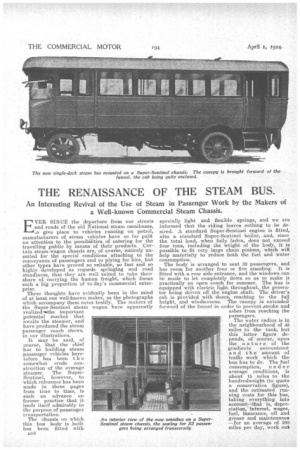THE RENAISSANCE OF THE STEAM BUS.
Page 12

Page 13

If you've noticed an error in this article please click here to report it so we can fix it.
An Interesting Revival of the Use of Steam in Passenger Work by the Makers of a Well-known Commercial Steam Chassis.
EITER SINCE the departure from our streets and roads of the old National steam omnibuses, ..o give place to vehicles running on petrol, manufacturers of steam vehicles have so far paid no attention to the possibilities of catering for the travelling public by means of their products. Certain steam-wagon chassis are, of epurse, entirely unsuited for the special conditions attaching to the conveyance of passengers and to plying for hire, but other types have proved so reliable, so fast and so highly developed as regards springing and road steadiness, that they are well suited to take their share of carrying the human freight, which forms such a big proportion of to-day's commercial enterprise.
It may be said, of course, that the chief bar to building steam passenger vehicles heretofore has been t h e somewhat crude construction of the average steamer. The SuperSentinel, however, to which reference has been made in these pages from time to time, is such an advance on former practice that it lends itself admirably to the purpose of passenger transportation. The chassis on which this bus , body is .built has been fitted with D18 specially light and flexible springs and we are informed that the riding leaves nothing to be desired. A standard Super-Sentinel engine is fitted, also a standard Super-Sentinel boiler,. and, since the total load, when fully laden, does not exceed four tons, including the weight of the body, it is possible to fit very large chain pinions, which will help materially to reduce both the fuel and water consumption.
The body is arranged to seat 32 passengers, and has room for another four or five standing. It is fitted with a. rear side entrance, and the windows can be made to let completely down so as to make it practically an open coach for summer. The bus is equipped with electric light throughout, the generator being driven off the engine shaft. The driver's cab is provided with doors, reaching to the full height, and windscreens. The canopy is extended forward of the funnel in order to prevent ..smoke and ashes from reaching the passengers.
The water radius is in the neighbourhood of 45 miles to the tank, but this latter figure depends, of course, upon the nature of the gradients encountered and the amount of traffic work which the bus has to do. The fuel consumption, under average conditions, is about 15 miles to the hundredweight (to quote a conservative figure), and the estimated running costs for this bus, taking everything into account—that is, depreciation, interest, wages, fuel, insurance, oil and grease and maintenance —for an average of 1410 miles per day, work out at 8.58 per bus-mile. If the vehicle is fully laden, this gives a cost of .27d. per passenger. mile, which. figure, it will be realized, is an extremely economical one, which compares • favourably with other types of vehicle.
• The fact that water has to be_lifted every 40 miles or 45 miles is really no detriment in longdistance passenger work, as passengers are nearly always glad for a few minutes in which to stretch their limbs.
We look forward with interest to further development of this steam passenger bus, and hope to give in the near future the results of some tests carried out by ourselves on the bus in question.






















































